By Ryan Tullock

Courtesy of the Library of Congress
I went on my first house tour when I was in the eighth grade. I toured The Hermitage in Nashville, Tennessee. I can almost remember every detail about that tour and was blown away by the fact that someone, albeit a very important someone, had their house turned into a museum. From that point on, it has been a wish of mine to be involved with a house museum of some sort. With that in mind, and knowing that desire was bubbling near the back of my mind, when the opportunity to work at Gorgas House in some respect presented itself, I could not help but jump at the opportunity! This was the opportunity I had been waiting for!
However, that’s getting a little ahead of myself. In the fall of 2016, I found myself in the Public History course being offered by Dr. Giggie. I was interested because I had never really considered Public History as line of work. To be honest, I did not know what Public History meant. As far as I knew, it could have been a course on writing books that appealed to the public, hence Public History. Whatever the reason, it caught my eye. At the very least, I could add it as a line on my Curriculum Vitae. Besides, what could it hurt? After a session or two, I realized that Public History was really just the idea of how the public interacts with history, whether that be through museums, publishing, digital humanities, or archival work. I could see myself in any of those disciplines, but still in the back of my mind was this desire to work in a house museum. Then Gorgas House opened as a possibility. I was hooked.
Now that I was on at the Gorgas House, the question turned to what I would make of my time there. When I had visited the house at an earlier date, I noticed that the mention of William Gorgas was contained almost exclusively to his time in the military. The remarkable thing is that Gorgas was much more than just a soldier. He oversaw sanitation in the Panama Canal zone, served as president of the American Medical Association, and most importantly was on the team that discovered that mosquitoes carry yellow fever! Yet none of this was being told. This rich history was shut up somewhere and I felt it my duty, if you will, to dig it out of the doldrums. My hope is that by the end of my time at Gorgas House, there will be a fully functional, online exhibit tracing the importance in the medical field of a man whose only accolade on this campus is as Surgeon General. While this is a noble title and a singularly important position, it only tells a very small portion of the story.
Lastly, having talked with Lydia Ellington Joffray, director of the Gorgas House, we both believe that this project is a great example of the mission of Gorgas House: to illuminate the lives of the Gorgas family and to educate people about this very important Alabama family. This project, as previously mentioned, will shine a light into the background of William Gorgas’ medical achievements.
In the end, I am excited to have the opportunity to work with the house and Hoole Library in illustrating this man’s background and how important he is, not only for the University of Alabama or United States military history, but also his great impact in the history of medicine.